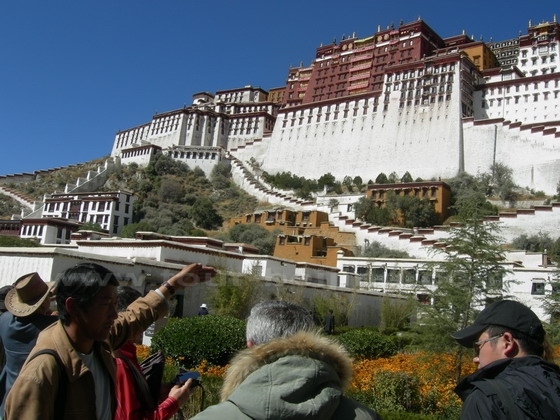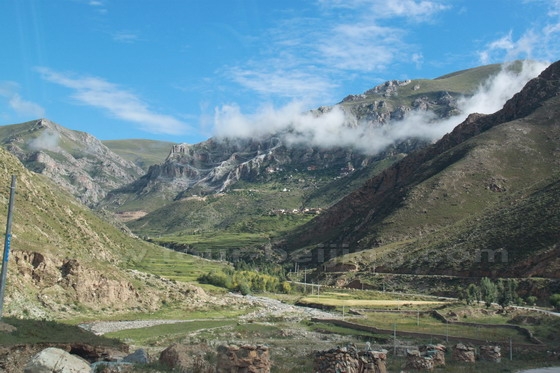
Plan a Lhasa Tour? Lhasa, the capital of China’s Tibet Autonomous Region, has a history of more than 1,300 years. It is the political, economic, cultural and transport center of the region. Lhasa is home to the Tibetan, Han, and Hui peoples, as well as many other ethnic groups, but the Tibetan ethnic group makes up 87 percent of the total population. because of its impressive heritage of over a thousand years of cultural and spiritual history, Lhasa is one of the most featured and dreamt-about cities in the world.
Features & Attractions
•Lhasa Potala Palace
•Lhasa Norbulingka
•Lhasa Potala Palace
•Lhasa Norbulingka
Potala Palace
Perched upon Marpo Ri hill, 130 meters above the Lhasa valley, the Potala Palace rises a further 170 meters and is the greatest monumental structure in all of Tibet. It is a huge treasure house of materials and articles from Tibetan history, religion, culture and art. The palace is widely known for the precious sculptures, murals, scriptures, Buddha statues, murals, antiques, and religious jewelry housed within. They are of great cultural and artistic value. The Potala Palace was declared a UNESCO World Cultural Heritage Site in 1994.
Tiket Price:
Perched upon Marpo Ri hill, 130 meters above the Lhasa valley, the Potala Palace rises a further 170 meters and is the greatest monumental structure in all of Tibet. It is a huge treasure house of materials and articles from Tibetan history, religion, culture and art. The palace is widely known for the precious sculptures, murals, scriptures, Buddha statues, murals, antiques, and religious jewelry housed within. They are of great cultural and artistic value. The Potala Palace was declared a UNESCO World Cultural Heritage Site in 1994.
Tiket Price:
100Yuan (1st Nov.-30th Apr.)
200Yuan(1st May-31st Oct.)
Opening Time:
200Yuan(1st May-31st Oct.)
Opening Time:
09:00-16:00 except holidays and major events
Tips: There are only 2300 tickets are issued each day, 1600 for the travel agents and 700 for the individual tourists.
Tips: There are only 2300 tickets are issued each day, 1600 for the travel agents and 700 for the individual tourists.
Lake Lhasa Norbulingka
NorbuLingka, colloquially named “Dalai Summer Palace”, is located west of Lhasa. The beautiful garden was first built in the middle 18th century. Norbulingka is the largest man-made garden in Tibet. The garden covers an area of 46 acres (19 hectares) and it is a three-storey palace with halls for worshipping Buddha, bedrooms, reading rooms and sanctuaries. In the garden visitors can worship Buddha, relax and study the Tibetan-style palaces.
Location: about 3km west of Lhasa
NorbuLingka, colloquially named “Dalai Summer Palace”, is located west of Lhasa. The beautiful garden was first built in the middle 18th century. Norbulingka is the largest man-made garden in Tibet. The garden covers an area of 46 acres (19 hectares) and it is a three-storey palace with halls for worshipping Buddha, bedrooms, reading rooms and sanctuaries. In the garden visitors can worship Buddha, relax and study the Tibetan-style palaces.
Location: about 3km west of Lhasa
Ticket Price: 70Yuan for each tourist; 2Yuan for Tibetan
Opening Time: 09:00-12:00 in the morning; 1500-16:00 in the afternoon
Opening Time: 09:00-12:00 in the morning; 1500-16:00 in the afternoon
Barkhor Street
Located in the center of Lhasa and surrounding the Jokhang Temple, Barkhor Street is a very ancient street. As the symbol of Lhasa, the Tibetan people are always proud of it. Buddhist pilgrims can be seen throughout the day and night walking, or prostrating themselves clockwise along Barkhor Street spinning their prayer wheels and chanting sutras. There is more to Barkhor Street than just a place for pilgrims to walk. Barkhor Street, often called the “Window of Tibet” is famous for its shopping.
Located in the center of Lhasa and surrounding the Jokhang Temple, Barkhor Street is a very ancient street. As the symbol of Lhasa, the Tibetan people are always proud of it. Buddhist pilgrims can be seen throughout the day and night walking, or prostrating themselves clockwise along Barkhor Street spinning their prayer wheels and chanting sutras. There is more to Barkhor Street than just a place for pilgrims to walk. Barkhor Street, often called the “Window of Tibet” is famous for its shopping.
Jokhang Temple
Located in teh center of old Lhasa city, Jokhang Temple has been listed inthe UNESCO’s Wrold Heritage in 2000. With an area of 25,100 square meters (about six acres), it is the ultimate pilgrimage destination for Tibetan Pilgrims. It was built by craftsmen from Tibet, China and Nepal and thus features different architectural styles. Jokhang means “House of Buddha”. Standing in the square of the Jokhang Temple, one can view the entire complex.
Price Ticket: 75Yuan
Opening Hours:09:00-18:00
How to get there: The temple is in the downtown so you can just walk there.
Located in teh center of old Lhasa city, Jokhang Temple has been listed inthe UNESCO’s Wrold Heritage in 2000. With an area of 25,100 square meters (about six acres), it is the ultimate pilgrimage destination for Tibetan Pilgrims. It was built by craftsmen from Tibet, China and Nepal and thus features different architectural styles. Jokhang means “House of Buddha”. Standing in the square of the Jokhang Temple, one can view the entire complex.
Price Ticket: 75Yuan
Opening Hours:09:00-18:00
How to get there: The temple is in the downtown so you can just walk there.
Lake Nam Co
Nam Co is the highest lake in the world and is 4,718 meters above sea level. It is 72 kilometers long from east to west and 30 kilometers wide from south to north. It has an area of 1,940 square kilometers. Some 60 kilometers to the northwest of Damxung County seat, it is one of the three holy lakes in Tibet and receives high respects among the local people.
Location: 200km northwest of Lhasa
Nam Co is the highest lake in the world and is 4,718 meters above sea level. It is 72 kilometers long from east to west and 30 kilometers wide from south to north. It has an area of 1,940 square kilometers. Some 60 kilometers to the northwest of Damxung County seat, it is one of the three holy lakes in Tibet and receives high respects among the local people.
Location: 200km northwest of Lhasa
Ticket Price:
120 for adult; 60 Yuan for children
Half Price from 1st Nov.-30th next Apr.
Free on Teachers’Day, Army Day, and Children’s Day depending on credentials
Half Price from 1st Nov.-30th next Apr.
Free on Teachers’Day, Army Day, and Children’s Day depending on credentials
Yangbajing Geothermal Hotspring
The Yangbajing Geothermal Hotspring, situated about 90kms northwest to Lhasa city, has many hot water wells and hot springs. Covering an area of 40 square kilometers, it is surrounded by pieces of grassland, which is green all year round. During bitter winter, when the temperature is usually -20℃ in the whole Tibet, the hot spring is still 30℃-40℃.Especially in the early morning when it is still cold, above the hotspring always permeates heavy white mirage, just like wonderland.
Location: Dangxiong County, 91.8km northwest of Lhasa
Ticket Price: 50Yuan (outdoor); 70Yuan (indoor)
How to get there: Take long-distance bus from Lhasa Coach Station
The Yangbajing Geothermal Hotspring, situated about 90kms northwest to Lhasa city, has many hot water wells and hot springs. Covering an area of 40 square kilometers, it is surrounded by pieces of grassland, which is green all year round. During bitter winter, when the temperature is usually -20℃ in the whole Tibet, the hot spring is still 30℃-40℃.Especially in the early morning when it is still cold, above the hotspring always permeates heavy white mirage, just like wonderland.
Location: Dangxiong County, 91.8km northwest of Lhasa
Ticket Price: 50Yuan (outdoor); 70Yuan (indoor)
How to get there: Take long-distance bus from Lhasa Coach Station
Sera Monastery
Sera, meaning “merciful hail” is a challenge to Drepung monastery, whose name means “rice heap” in the sense that hail damages rice. Founded in 1419, at its height, Sera monastery was residence to more than 5,000 monks and five monastic colleges. Although much less active now, with only several hundred monks currently in residence, one of the most interesting times to visit the monastery is in the afternoon when monks, after finishing their morning scripture classes, can be seen debating in the courtyard.
Location: Chenggua, Lhasa City
Ticket Price: 55Yuan
Opening Time: 09:00-16:00
How to get there: 15yuan by taxi
Sera, meaning “merciful hail” is a challenge to Drepung monastery, whose name means “rice heap” in the sense that hail damages rice. Founded in 1419, at its height, Sera monastery was residence to more than 5,000 monks and five monastic colleges. Although much less active now, with only several hundred monks currently in residence, one of the most interesting times to visit the monastery is in the afternoon when monks, after finishing their morning scripture classes, can be seen debating in the courtyard.
Location: Chenggua, Lhasa City
Ticket Price: 55Yuan
Opening Time: 09:00-16:00
How to get there: 15yuan by taxi
Tibet Museum
The Tibet Museum is located in the southeast corner of Norbu Lingka, Lhasa city. It covers an area of 23,508 square meters. It was officially inaugurated in October of 1999, with a permanent collection that celebrates the History of Tibetan Culture. The design of the exhibit uses traditional Tibetan architecture such as Tibetan doors, beam-decoration, patterns and so on, in order to create the atmosphere of authentic Tibetan art
Location: No.19, Norbulingka Road, Lhasa City
Ticket Price: free
Opening Hours: 10:00-18:00
How to get there: Bus No. 86, 98, 106, 109, 201, 203, 204
The Tibet Museum is located in the southeast corner of Norbu Lingka, Lhasa city. It covers an area of 23,508 square meters. It was officially inaugurated in October of 1999, with a permanent collection that celebrates the History of Tibetan Culture. The design of the exhibit uses traditional Tibetan architecture such as Tibetan doors, beam-decoration, patterns and so on, in order to create the atmosphere of authentic Tibetan art
Location: No.19, Norbulingka Road, Lhasa City
Ticket Price: free
Opening Hours: 10:00-18:00
How to get there: Bus No. 86, 98, 106, 109, 201, 203, 204
Lhasa Travel Service
Lhasa 4 Days Highlight Tour ( LXA-01 ) from US$290p/p
5 Days Lhasa and Namtso Lake Tour ( LXA-02 ) from US$360p/p
6 Days Beijing Lhasa Train Travel ( LXA-03 ) from US$490p/p






